Financial Management: Statement Analysis & Business Performance
VerifiedAdded on 2023/06/14
|12
|2458
|149
Report
AI Summary
This report delves into the importance of financial management for effective business operations, focusing on financial governance, statement analysis, and ratio utilization. It examines liquidity, profitability, and efficiency ratios using a case study with balance sheets and income statements. The report analyzes business performance, suggesting strategies for improvement and identifying key factors for evaluation. It covers the concept and importance of financial management, including effective asset usage, financial decision-making, fund acquisition, and firm value enhancement. The report also discusses the main financial statements—profit and loss, financial performance, and cash flow—and their use in financial management. A business review template is completed, analyzing profitability, liquidity, and efficiency ratios. The case study identifies areas for improvement, such as declining current assets and increased net profit, and suggests strategies like efficient resource utilization and marketing enhancements. The conclusion emphasizes the crucial role of financial management in allocating funds, aiding decision-making, and ensuring solvency and profitability.

Importance of financial
management
management
Paraphrase This Document
Need a fresh take? Get an instant paraphrase of this document with our AI Paraphraser

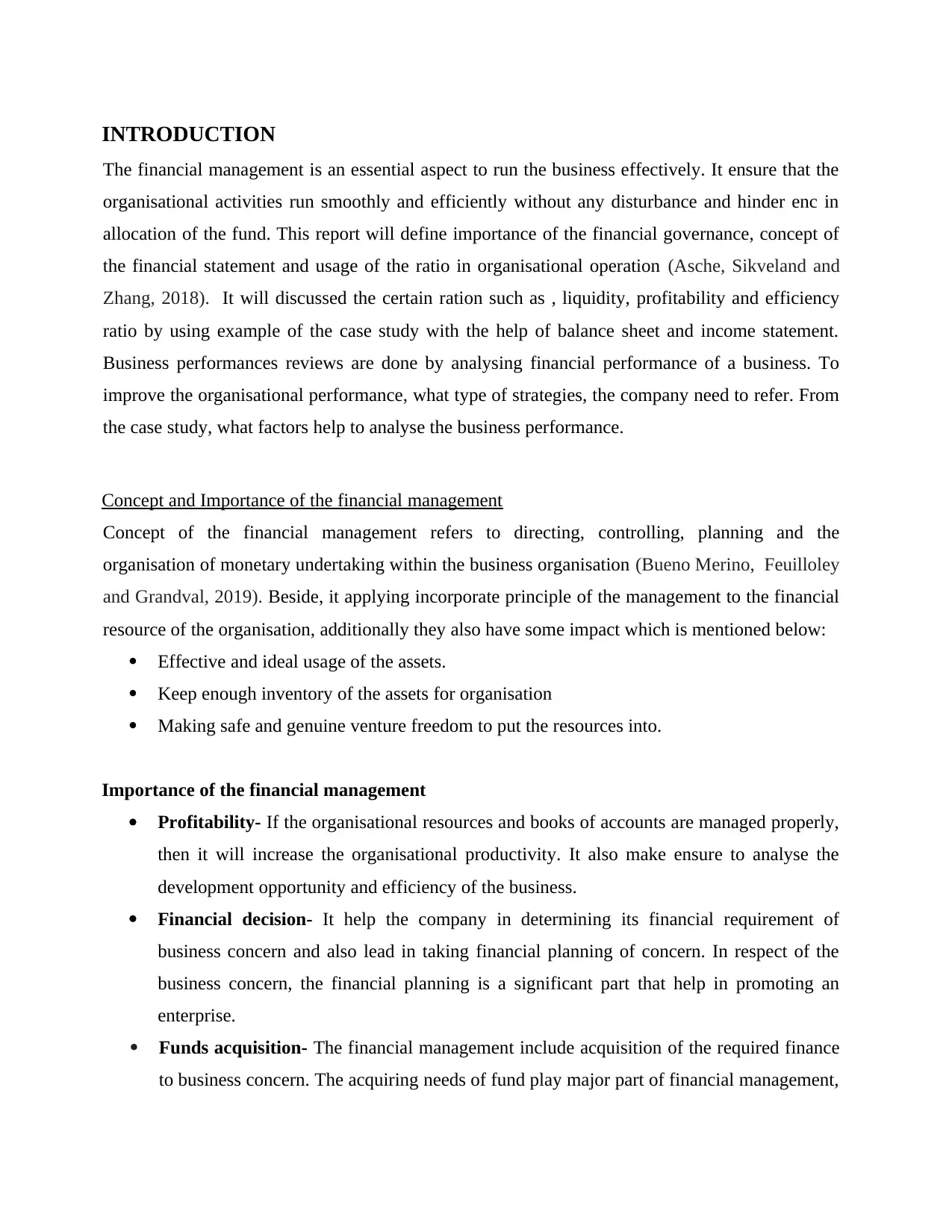
INTRODUCTION
The financial management is an essential aspect to run the business effectively. It ensure that the
organisational activities run smoothly and efficiently without any disturbance and hinder enc in
allocation of the fund. This report will define importance of the financial governance, concept of
the financial statement and usage of the ratio in organisational operation (Asche, Sikveland and
Zhang, 2018). It will discussed the certain ration such as , liquidity, profitability and efficiency
ratio by using example of the case study with the help of balance sheet and income statement.
Business performances reviews are done by analysing financial performance of a business. To
improve the organisational performance, what type of strategies, the company need to refer. From
the case study, what factors help to analyse the business performance.
Concept and Importance of the financial management
Concept of the financial management refers to directing, controlling, planning and the
organisation of monetary undertaking within the business organisation (Bueno Merino, Feuilloley
and Grandval, 2019). Beside, it applying incorporate principle of the management to the financial
resource of the organisation, additionally they also have some impact which is mentioned below:
Effective and ideal usage of the assets.
Keep enough inventory of the assets for organisation
Making safe and genuine venture freedom to put the resources into.
Importance of the financial management
Profitability- If the organisational resources and books of accounts are managed properly,
then it will increase the organisational productivity. It also make ensure to analyse the
development opportunity and efficiency of the business.
Financial decision- It help the company in determining its financial requirement of
business concern and also lead in taking financial planning of concern. In respect of the
business concern, the financial planning is a significant part that help in promoting an
enterprise.
Funds acquisition- The financial management include acquisition of the required finance
to business concern. The acquiring needs of fund play major part of financial management,
The financial management is an essential aspect to run the business effectively. It ensure that the
organisational activities run smoothly and efficiently without any disturbance and hinder enc in
allocation of the fund. This report will define importance of the financial governance, concept of
the financial statement and usage of the ratio in organisational operation (Asche, Sikveland and
Zhang, 2018). It will discussed the certain ration such as , liquidity, profitability and efficiency
ratio by using example of the case study with the help of balance sheet and income statement.
Business performances reviews are done by analysing financial performance of a business. To
improve the organisational performance, what type of strategies, the company need to refer. From
the case study, what factors help to analyse the business performance.
Concept and Importance of the financial management
Concept of the financial management refers to directing, controlling, planning and the
organisation of monetary undertaking within the business organisation (Bueno Merino, Feuilloley
and Grandval, 2019). Beside, it applying incorporate principle of the management to the financial
resource of the organisation, additionally they also have some impact which is mentioned below:
Effective and ideal usage of the assets.
Keep enough inventory of the assets for organisation
Making safe and genuine venture freedom to put the resources into.
Importance of the financial management
Profitability- If the organisational resources and books of accounts are managed properly,
then it will increase the organisational productivity. It also make ensure to analyse the
development opportunity and efficiency of the business.
Financial decision- It help the company in determining its financial requirement of
business concern and also lead in taking financial planning of concern. In respect of the
business concern, the financial planning is a significant part that help in promoting an
enterprise.
Funds acquisition- The financial management include acquisition of the required finance
to business concern. The acquiring needs of fund play major part of financial management,
⊘ This is a preview!⊘
Do you want full access?
Subscribe today to unlock all pages.

Trusted by 1+ million students worldwide
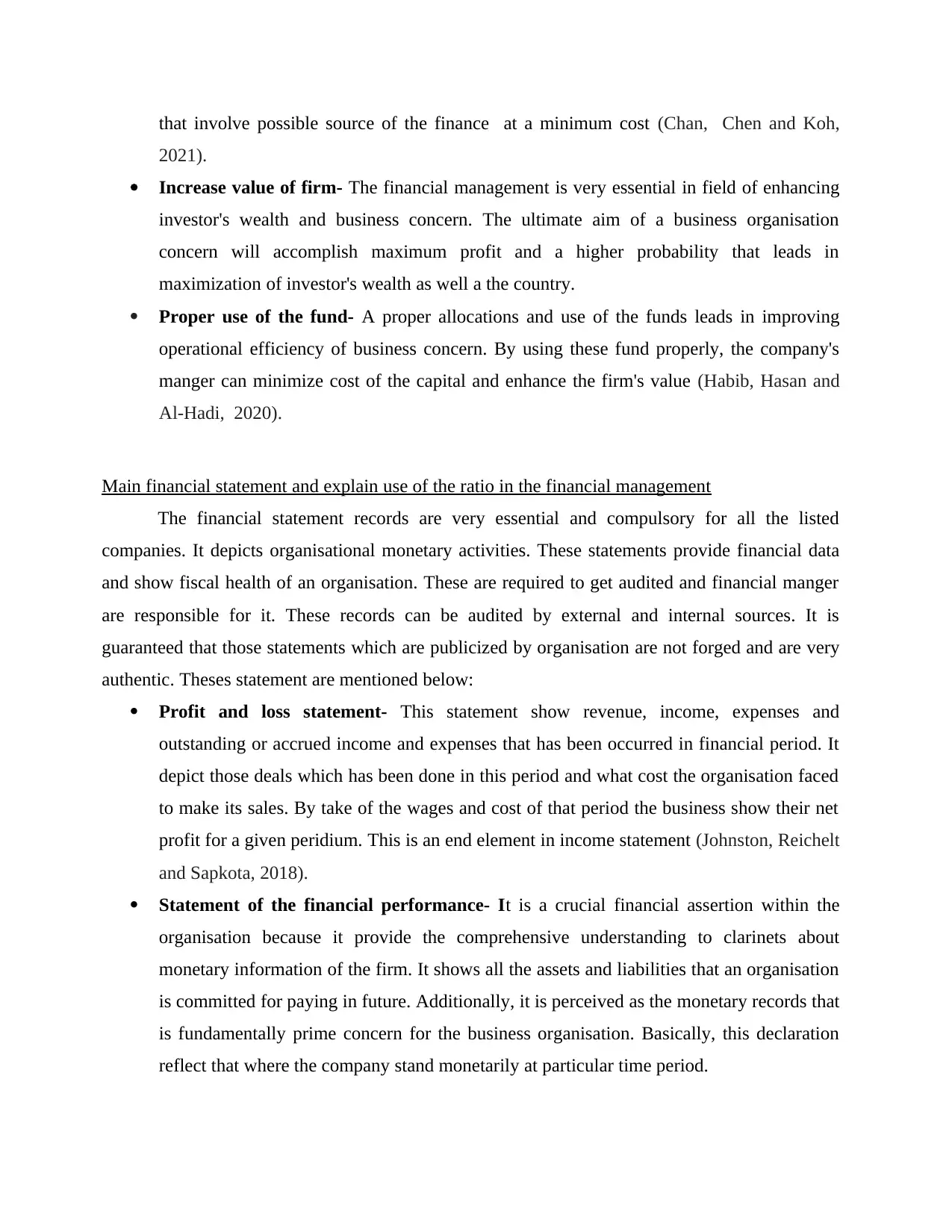
that involve possible source of the finance at a minimum cost (Chan, Chen and Koh,
2021).
Increase value of firm- The financial management is very essential in field of enhancing
investor's wealth and business concern. The ultimate aim of a business organisation
concern will accomplish maximum profit and a higher probability that leads in
maximization of investor's wealth as well a the country.
Proper use of the fund- A proper allocations and use of the funds leads in improving
operational efficiency of business concern. By using these fund properly, the company's
manger can minimize cost of the capital and enhance the firm's value (Habib, Hasan and
Al‐Hadi, 2020).
Main financial statement and explain use of the ratio in the financial management
The financial statement records are very essential and compulsory for all the listed
companies. It depicts organisational monetary activities. These statements provide financial data
and show fiscal health of an organisation. These are required to get audited and financial manger
are responsible for it. These records can be audited by external and internal sources. It is
guaranteed that those statements which are publicized by organisation are not forged and are very
authentic. Theses statement are mentioned below:
Profit and loss statement- This statement show revenue, income, expenses and
outstanding or accrued income and expenses that has been occurred in financial period. It
depict those deals which has been done in this period and what cost the organisation faced
to make its sales. By take of the wages and cost of that period the business show their net
profit for a given peridium. This is an end element in income statement (Johnston, Reichelt
and Sapkota, 2018).
Statement of the financial performance- It is a crucial financial assertion within the
organisation because it provide the comprehensive understanding to clarinets about
monetary information of the firm. It shows all the assets and liabilities that an organisation
is committed for paying in future. Additionally, it is perceived as the monetary records that
is fundamentally prime concern for the business organisation. Basically, this declaration
reflect that where the company stand monetarily at particular time period.
2021).
Increase value of firm- The financial management is very essential in field of enhancing
investor's wealth and business concern. The ultimate aim of a business organisation
concern will accomplish maximum profit and a higher probability that leads in
maximization of investor's wealth as well a the country.
Proper use of the fund- A proper allocations and use of the funds leads in improving
operational efficiency of business concern. By using these fund properly, the company's
manger can minimize cost of the capital and enhance the firm's value (Habib, Hasan and
Al‐Hadi, 2020).
Main financial statement and explain use of the ratio in the financial management
The financial statement records are very essential and compulsory for all the listed
companies. It depicts organisational monetary activities. These statements provide financial data
and show fiscal health of an organisation. These are required to get audited and financial manger
are responsible for it. These records can be audited by external and internal sources. It is
guaranteed that those statements which are publicized by organisation are not forged and are very
authentic. Theses statement are mentioned below:
Profit and loss statement- This statement show revenue, income, expenses and
outstanding or accrued income and expenses that has been occurred in financial period. It
depict those deals which has been done in this period and what cost the organisation faced
to make its sales. By take of the wages and cost of that period the business show their net
profit for a given peridium. This is an end element in income statement (Johnston, Reichelt
and Sapkota, 2018).
Statement of the financial performance- It is a crucial financial assertion within the
organisation because it provide the comprehensive understanding to clarinets about
monetary information of the firm. It shows all the assets and liabilities that an organisation
is committed for paying in future. Additionally, it is perceived as the monetary records that
is fundamentally prime concern for the business organisation. Basically, this declaration
reflect that where the company stand monetarily at particular time period.
Paraphrase This Document
Need a fresh take? Get an instant paraphrase of this document with our AI Paraphraser
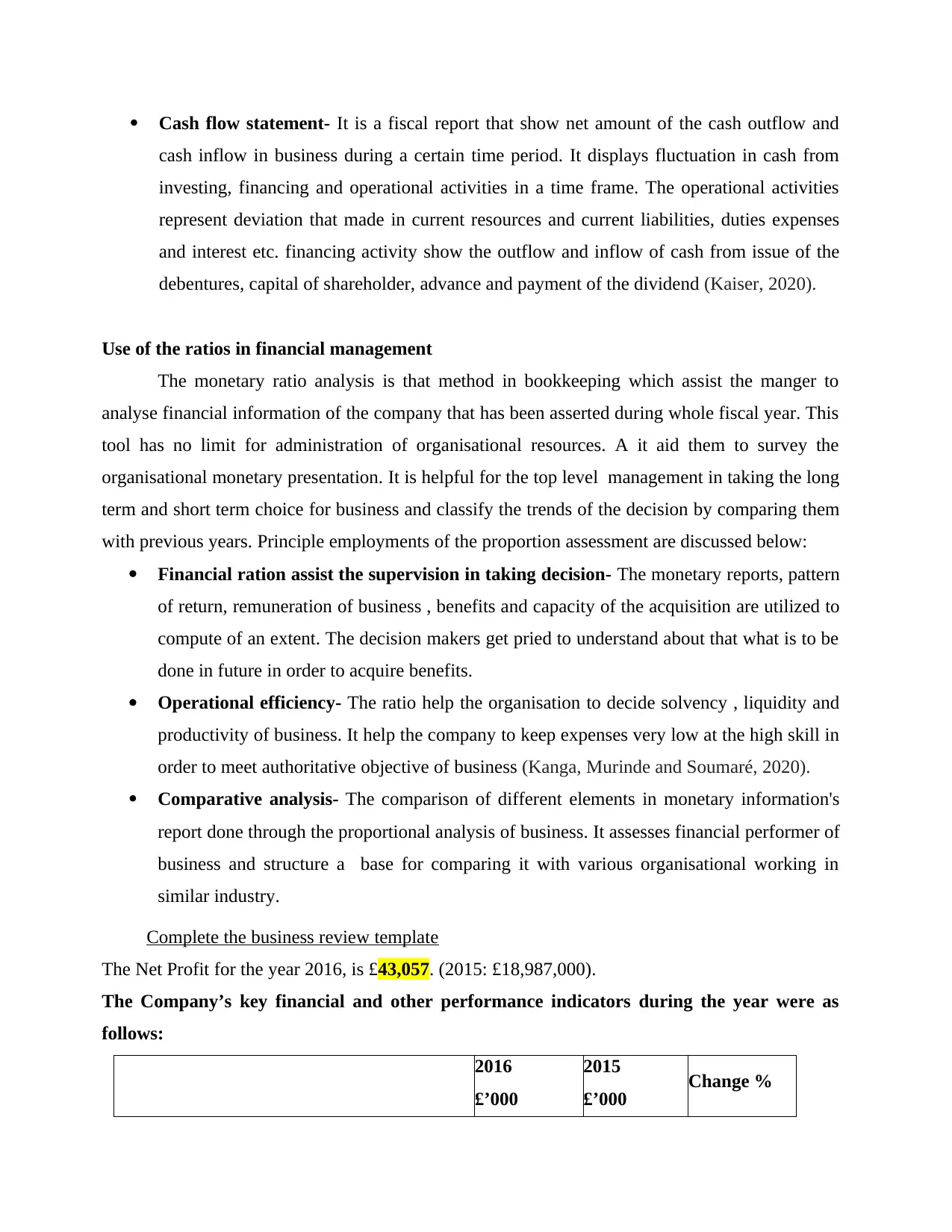
Cash flow statement- It is a fiscal report that show net amount of the cash outflow and
cash inflow in business during a certain time period. It displays fluctuation in cash from
investing, financing and operational activities in a time frame. The operational activities
represent deviation that made in current resources and current liabilities, duties expenses
and interest etc. financing activity show the outflow and inflow of cash from issue of the
debentures, capital of shareholder, advance and payment of the dividend (Kaiser, 2020).
Use of the ratios in financial management
The monetary ratio analysis is that method in bookkeeping which assist the manger to
analyse financial information of the company that has been asserted during whole fiscal year. This
tool has no limit for administration of organisational resources. A it aid them to survey the
organisational monetary presentation. It is helpful for the top level management in taking the long
term and short term choice for business and classify the trends of the decision by comparing them
with previous years. Principle employments of the proportion assessment are discussed below:
Financial ration assist the supervision in taking decision- The monetary reports, pattern
of return, remuneration of business , benefits and capacity of the acquisition are utilized to
compute of an extent. The decision makers get pried to understand about that what is to be
done in future in order to acquire benefits.
Operational efficiency- The ratio help the organisation to decide solvency , liquidity and
productivity of business. It help the company to keep expenses very low at the high skill in
order to meet authoritative objective of business (Kanga, Murinde and Soumaré, 2020).
Comparative analysis- The comparison of different elements in monetary information's
report done through the proportional analysis of business. It assesses financial performer of
business and structure a base for comparing it with various organisational working in
similar industry.
Complete the business review template
The Net Profit for the year 2016, is £43,057. (2015: £18,987,000).
The Company’s key financial and other performance indicators during the year were as
follows:
2016
£’000
2015
£’000 Change %
cash inflow in business during a certain time period. It displays fluctuation in cash from
investing, financing and operational activities in a time frame. The operational activities
represent deviation that made in current resources and current liabilities, duties expenses
and interest etc. financing activity show the outflow and inflow of cash from issue of the
debentures, capital of shareholder, advance and payment of the dividend (Kaiser, 2020).
Use of the ratios in financial management
The monetary ratio analysis is that method in bookkeeping which assist the manger to
analyse financial information of the company that has been asserted during whole fiscal year. This
tool has no limit for administration of organisational resources. A it aid them to survey the
organisational monetary presentation. It is helpful for the top level management in taking the long
term and short term choice for business and classify the trends of the decision by comparing them
with previous years. Principle employments of the proportion assessment are discussed below:
Financial ration assist the supervision in taking decision- The monetary reports, pattern
of return, remuneration of business , benefits and capacity of the acquisition are utilized to
compute of an extent. The decision makers get pried to understand about that what is to be
done in future in order to acquire benefits.
Operational efficiency- The ratio help the organisation to decide solvency , liquidity and
productivity of business. It help the company to keep expenses very low at the high skill in
order to meet authoritative objective of business (Kanga, Murinde and Soumaré, 2020).
Comparative analysis- The comparison of different elements in monetary information's
report done through the proportional analysis of business. It assesses financial performer of
business and structure a base for comparing it with various organisational working in
similar industry.
Complete the business review template
The Net Profit for the year 2016, is £43,057. (2015: £18,987,000).
The Company’s key financial and other performance indicators during the year were as
follows:
2016
£’000
2015
£’000 Change %
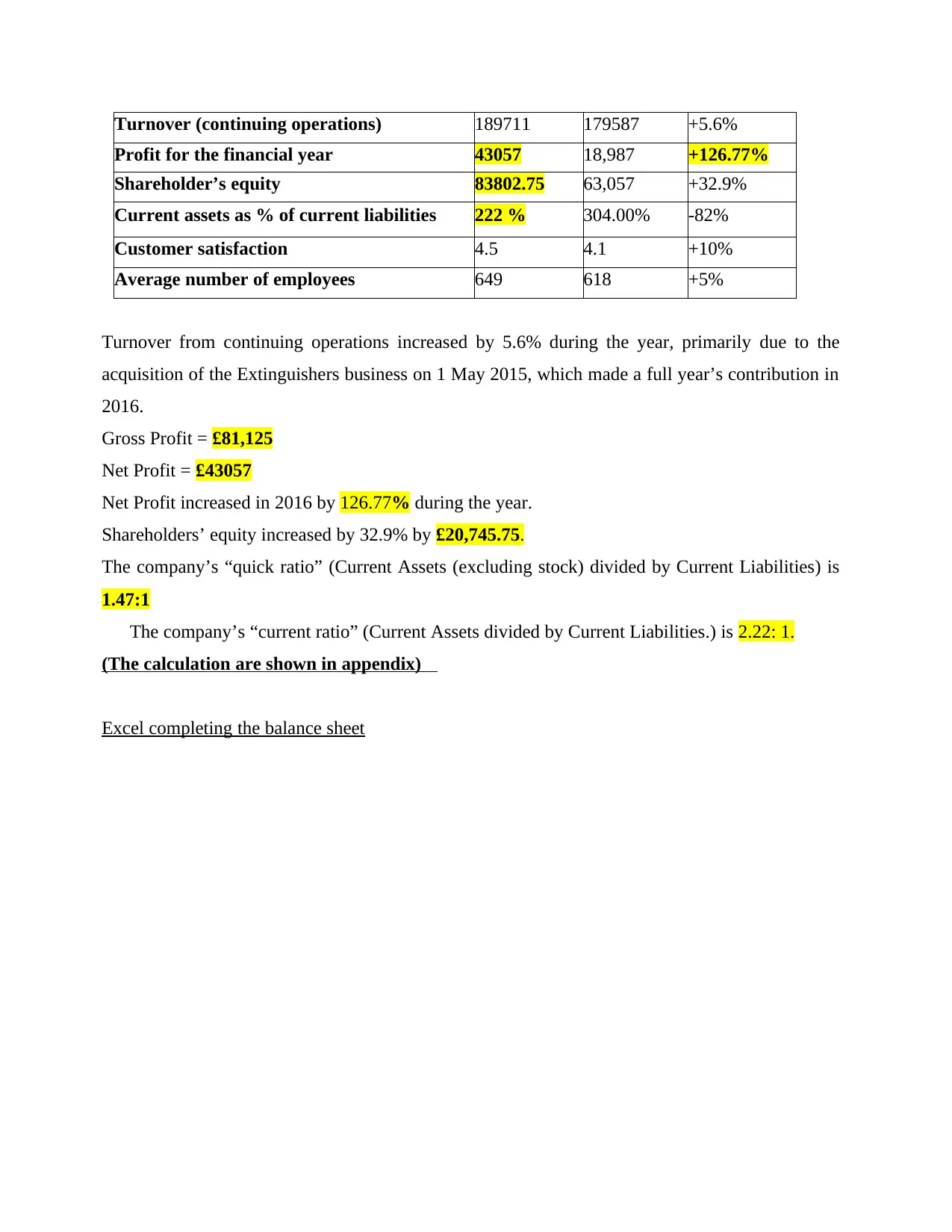
Turnover (continuing operations) 189711 179587 +5.6%
Profit for the financial year 43057 18,987 +126.77%
Shareholder’s equity 83802.75 63,057 +32.9%
Current assets as % of current liabilities 222 % 304.00% -82%
Customer satisfaction 4.5 4.1 +10%
Average number of employees 649 618 +5%
Turnover from continuing operations increased by 5.6% during the year, primarily due to the
acquisition of the Extinguishers business on 1 May 2015, which made a full year’s contribution in
2016.
Gross Profit = £81,125
Net Profit = £43057
Net Profit increased in 2016 by 126.77% during the year.
Shareholders’ equity increased by 32.9% by £20,745.75.
The company’s “quick ratio” (Current Assets (excluding stock) divided by Current Liabilities) is
1.47:1
The company’s “current ratio” (Current Assets divided by Current Liabilities.) is 2.22: 1.
(The calculation are shown in appendix)
Excel completing the balance sheet
Profit for the financial year 43057 18,987 +126.77%
Shareholder’s equity 83802.75 63,057 +32.9%
Current assets as % of current liabilities 222 % 304.00% -82%
Customer satisfaction 4.5 4.1 +10%
Average number of employees 649 618 +5%
Turnover from continuing operations increased by 5.6% during the year, primarily due to the
acquisition of the Extinguishers business on 1 May 2015, which made a full year’s contribution in
2016.
Gross Profit = £81,125
Net Profit = £43057
Net Profit increased in 2016 by 126.77% during the year.
Shareholders’ equity increased by 32.9% by £20,745.75.
The company’s “quick ratio” (Current Assets (excluding stock) divided by Current Liabilities) is
1.47:1
The company’s “current ratio” (Current Assets divided by Current Liabilities.) is 2.22: 1.
(The calculation are shown in appendix)
Excel completing the balance sheet
⊘ This is a preview!⊘
Do you want full access?
Subscribe today to unlock all pages.

Trusted by 1+ million students worldwide
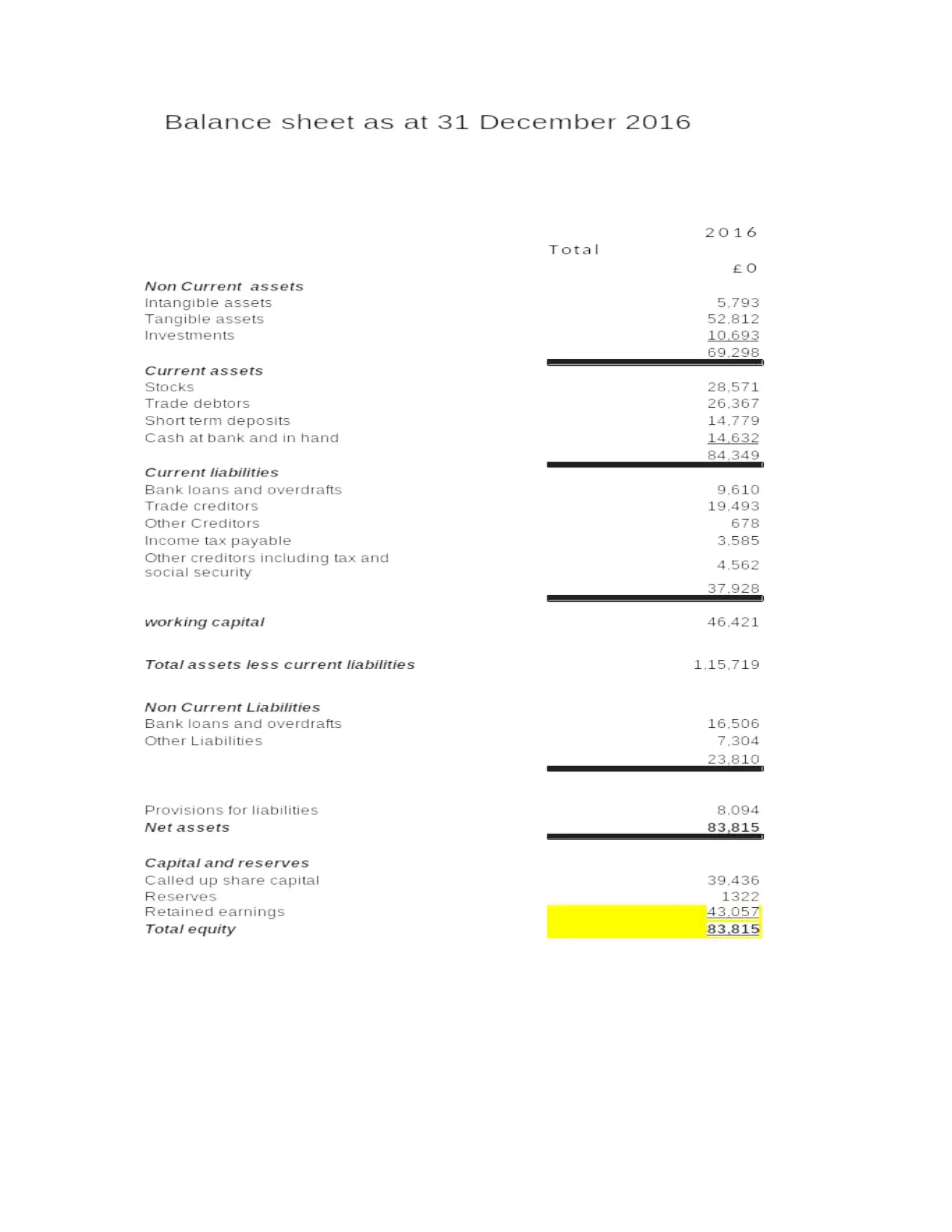
Paraphrase This Document
Need a fresh take? Get an instant paraphrase of this document with our AI Paraphraser
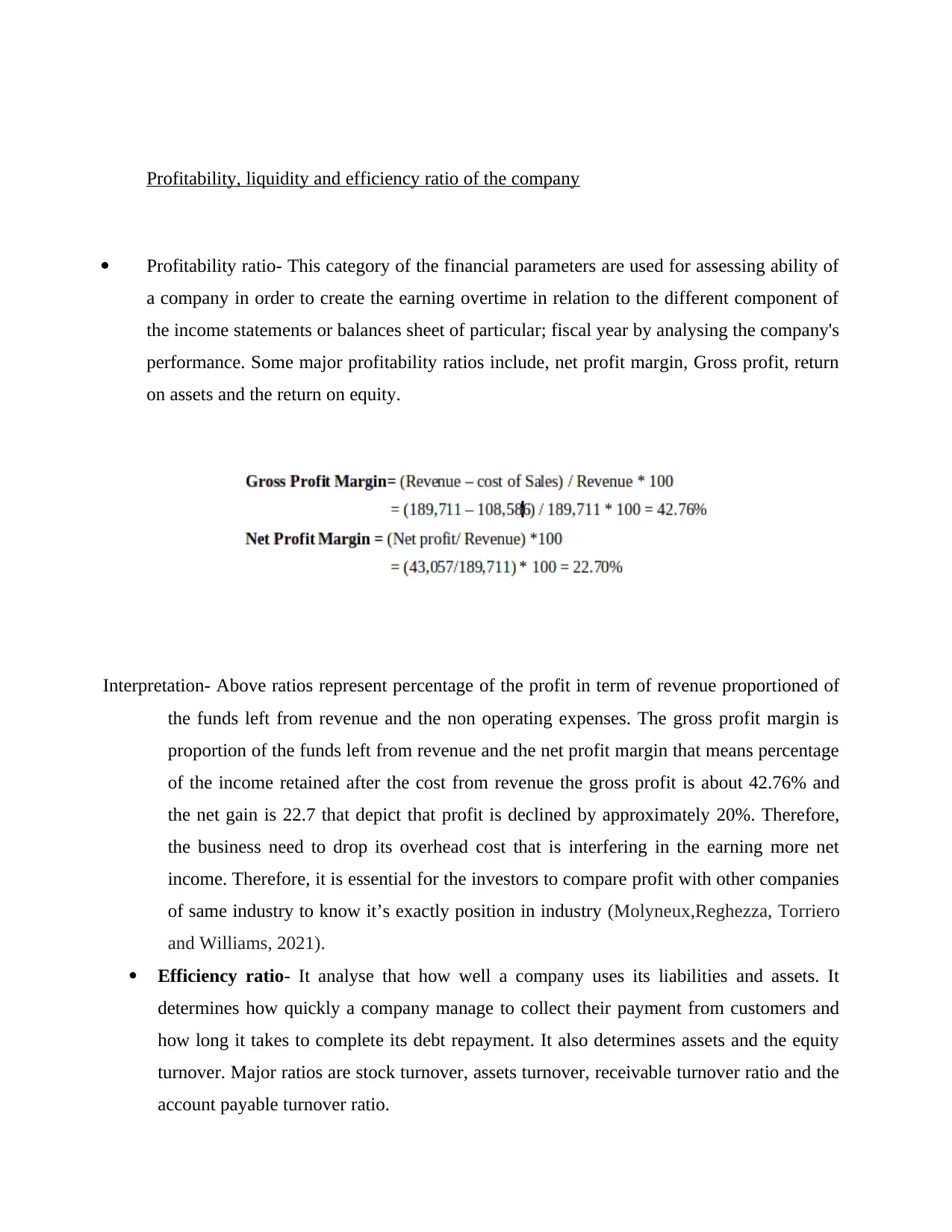
Profitability, liquidity and efficiency ratio of the company
Profitability ratio- This category of the financial parameters are used for assessing ability of
a company in order to create the earning overtime in relation to the different component of
the income statements or balances sheet of particular; fiscal year by analysing the company's
performance. Some major profitability ratios include, net profit margin, Gross profit, return
on assets and the return on equity.
Interpretation- Above ratios represent percentage of the profit in term of revenue proportioned of
the funds left from revenue and the non operating expenses. The gross profit margin is
proportion of the funds left from revenue and the net profit margin that means percentage
of the income retained after the cost from revenue the gross profit is about 42.76% and
the net gain is 22.7 that depict that profit is declined by approximately 20%. Therefore,
the business need to drop its overhead cost that is interfering in the earning more net
income. Therefore, it is essential for the investors to compare profit with other companies
of same industry to know it’s exactly position in industry (Molyneux,Reghezza, Torriero
and Williams, 2021).
Efficiency ratio- It analyse that how well a company uses its liabilities and assets. It
determines how quickly a company manage to collect their payment from customers and
how long it takes to complete its debt repayment. It also determines assets and the equity
turnover. Major ratios are stock turnover, assets turnover, receivable turnover ratio and the
account payable turnover ratio.
Profitability ratio- This category of the financial parameters are used for assessing ability of
a company in order to create the earning overtime in relation to the different component of
the income statements or balances sheet of particular; fiscal year by analysing the company's
performance. Some major profitability ratios include, net profit margin, Gross profit, return
on assets and the return on equity.
Interpretation- Above ratios represent percentage of the profit in term of revenue proportioned of
the funds left from revenue and the non operating expenses. The gross profit margin is
proportion of the funds left from revenue and the net profit margin that means percentage
of the income retained after the cost from revenue the gross profit is about 42.76% and
the net gain is 22.7 that depict that profit is declined by approximately 20%. Therefore,
the business need to drop its overhead cost that is interfering in the earning more net
income. Therefore, it is essential for the investors to compare profit with other companies
of same industry to know it’s exactly position in industry (Molyneux,Reghezza, Torriero
and Williams, 2021).
Efficiency ratio- It analyse that how well a company uses its liabilities and assets. It
determines how quickly a company manage to collect their payment from customers and
how long it takes to complete its debt repayment. It also determines assets and the equity
turnover. Major ratios are stock turnover, assets turnover, receivable turnover ratio and the
account payable turnover ratio.
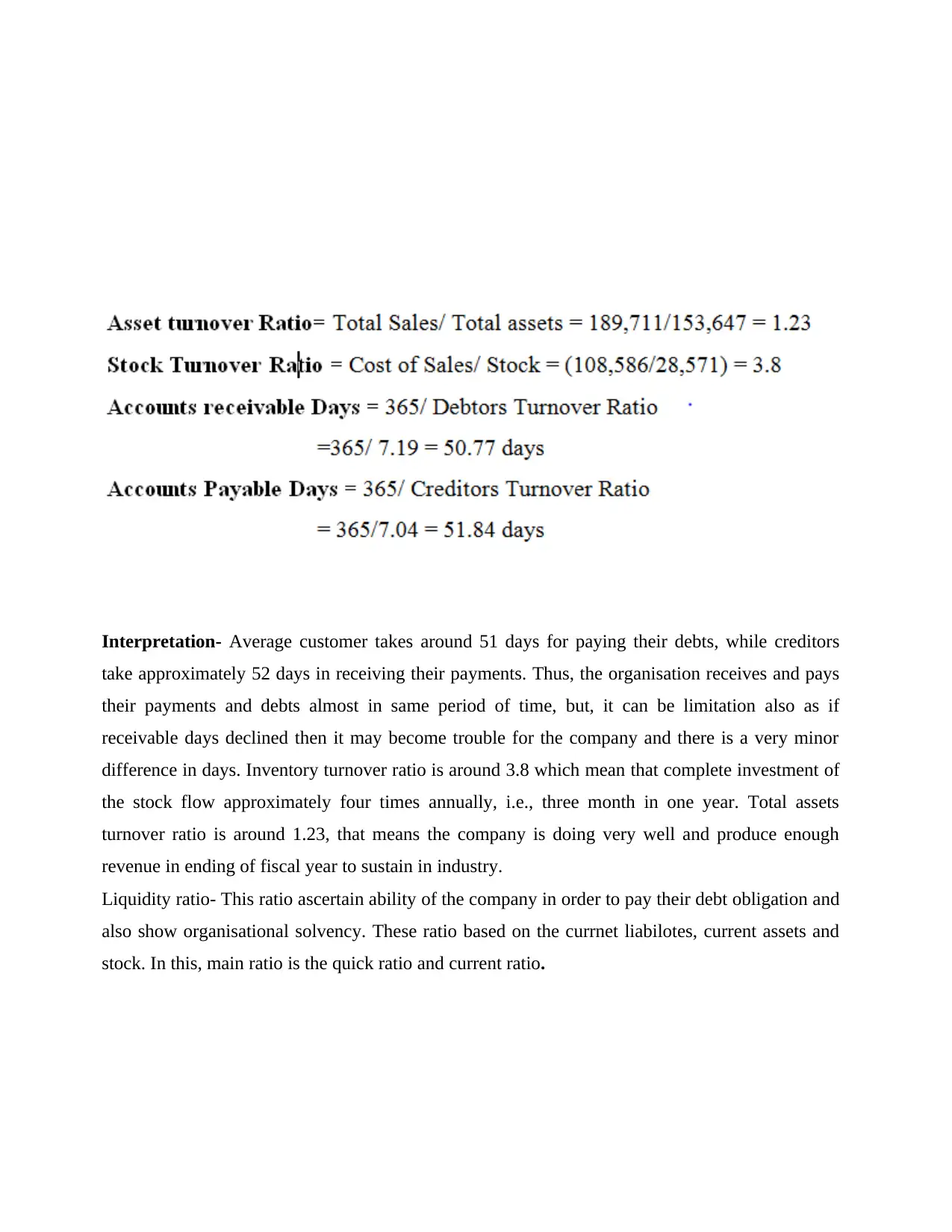
Interpretation- Average customer takes around 51 days for paying their debts, while creditors
take approximately 52 days in receiving their payments. Thus, the organisation receives and pays
their payments and debts almost in same period of time, but, it can be limitation also as if
receivable days declined then it may become trouble for the company and there is a very minor
difference in days. Inventory turnover ratio is around 3.8 which mean that complete investment of
the stock flow approximately four times annually, i.e., three month in one year. Total assets
turnover ratio is around 1.23, that means the company is doing very well and produce enough
revenue in ending of fiscal year to sustain in industry.
Liquidity ratio- This ratio ascertain ability of the company in order to pay their debt obligation and
also show organisational solvency. These ratio based on the currnet liabilotes, current assets and
stock. In this, main ratio is the quick ratio and current ratio.
take approximately 52 days in receiving their payments. Thus, the organisation receives and pays
their payments and debts almost in same period of time, but, it can be limitation also as if
receivable days declined then it may become trouble for the company and there is a very minor
difference in days. Inventory turnover ratio is around 3.8 which mean that complete investment of
the stock flow approximately four times annually, i.e., three month in one year. Total assets
turnover ratio is around 1.23, that means the company is doing very well and produce enough
revenue in ending of fiscal year to sustain in industry.
Liquidity ratio- This ratio ascertain ability of the company in order to pay their debt obligation and
also show organisational solvency. These ratio based on the currnet liabilotes, current assets and
stock. In this, main ratio is the quick ratio and current ratio.
⊘ This is a preview!⊘
Do you want full access?
Subscribe today to unlock all pages.

Trusted by 1+ million students worldwide
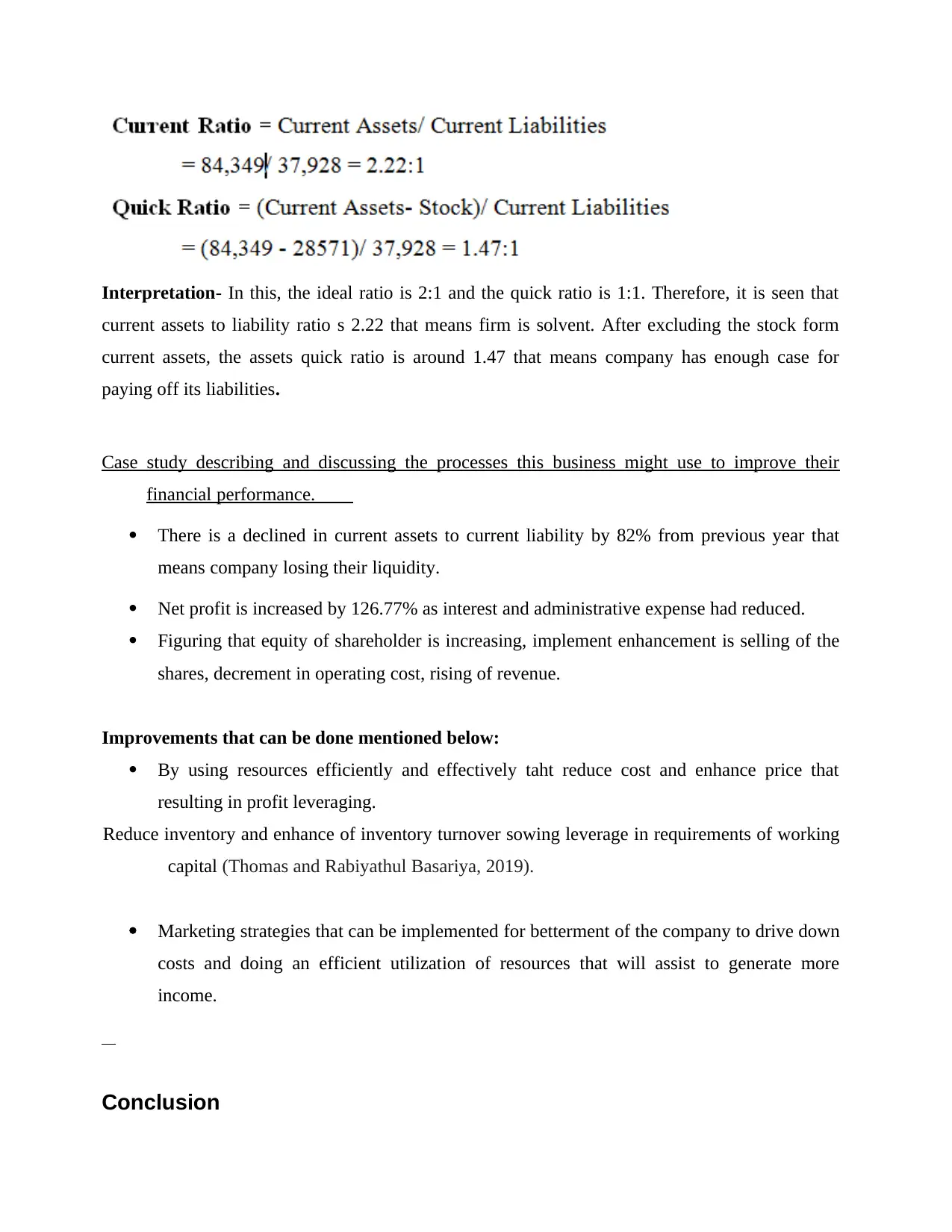
Interpretation- In this, the ideal ratio is 2:1 and the quick ratio is 1:1. Therefore, it is seen that
current assets to liability ratio s 2.22 that means firm is solvent. After excluding the stock form
current assets, the assets quick ratio is around 1.47 that means company has enough case for
paying off its liabilities.
Case study describing and discussing the processes this business might use to improve their
financial performance.
There is a declined in current assets to current liability by 82% from previous year that
means company losing their liquidity.
Net profit is increased by 126.77% as interest and administrative expense had reduced.
Figuring that equity of shareholder is increasing, implement enhancement is selling of the
shares, decrement in operating cost, rising of revenue.
Improvements that can be done mentioned below:
By using resources efficiently and effectively taht reduce cost and enhance price that
resulting in profit leveraging.
Reduce inventory and enhance of inventory turnover sowing leverage in requirements of working
capital (Thomas and Rabiyathul Basariya, 2019).
Marketing strategies that can be implemented for betterment of the company to drive down
costs and doing an efficient utilization of resources that will assist to generate more
income.
Conclusion
current assets to liability ratio s 2.22 that means firm is solvent. After excluding the stock form
current assets, the assets quick ratio is around 1.47 that means company has enough case for
paying off its liabilities.
Case study describing and discussing the processes this business might use to improve their
financial performance.
There is a declined in current assets to current liability by 82% from previous year that
means company losing their liquidity.
Net profit is increased by 126.77% as interest and administrative expense had reduced.
Figuring that equity of shareholder is increasing, implement enhancement is selling of the
shares, decrement in operating cost, rising of revenue.
Improvements that can be done mentioned below:
By using resources efficiently and effectively taht reduce cost and enhance price that
resulting in profit leveraging.
Reduce inventory and enhance of inventory turnover sowing leverage in requirements of working
capital (Thomas and Rabiyathul Basariya, 2019).
Marketing strategies that can be implemented for betterment of the company to drive down
costs and doing an efficient utilization of resources that will assist to generate more
income.
Conclusion
Paraphrase This Document
Need a fresh take? Get an instant paraphrase of this document with our AI Paraphraser
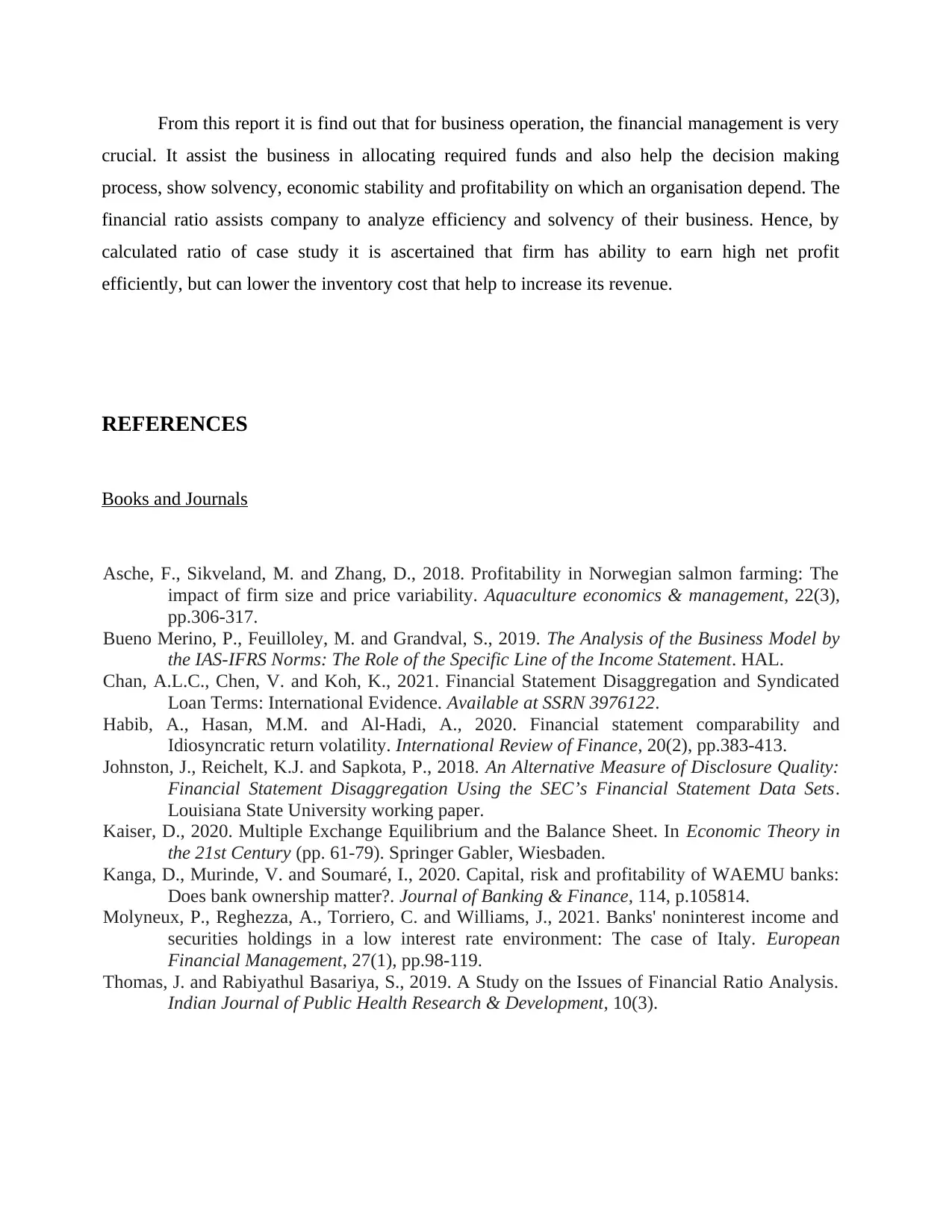
From this report it is find out that for business operation, the financial management is very
crucial. It assist the business in allocating required funds and also help the decision making
process, show solvency, economic stability and profitability on which an organisation depend. The
financial ratio assists company to analyze efficiency and solvency of their business. Hence, by
calculated ratio of case study it is ascertained that firm has ability to earn high net profit
efficiently, but can lower the inventory cost that help to increase its revenue.
REFERENCES
Books and Journals
Asche, F., Sikveland, M. and Zhang, D., 2018. Profitability in Norwegian salmon farming: The
impact of firm size and price variability. Aquaculture economics & management, 22(3),
pp.306-317.
Bueno Merino, P., Feuilloley, M. and Grandval, S., 2019. The Analysis of the Business Model by
the IAS-IFRS Norms: The Role of the Specific Line of the Income Statement. HAL.
Chan, A.L.C., Chen, V. and Koh, K., 2021. Financial Statement Disaggregation and Syndicated
Loan Terms: International Evidence. Available at SSRN 3976122.
Habib, A., Hasan, M.M. and Al‐Hadi, A., 2020. Financial statement comparability and
Idiosyncratic return volatility. International Review of Finance, 20(2), pp.383-413.
Johnston, J., Reichelt, K.J. and Sapkota, P., 2018. An Alternative Measure of Disclosure Quality:
Financial Statement Disaggregation Using the SEC’s Financial Statement Data Sets.
Louisiana State University working paper.
Kaiser, D., 2020. Multiple Exchange Equilibrium and the Balance Sheet. In Economic Theory in
the 21st Century (pp. 61-79). Springer Gabler, Wiesbaden.
Kanga, D., Murinde, V. and Soumaré, I., 2020. Capital, risk and profitability of WAEMU banks:
Does bank ownership matter?. Journal of Banking & Finance, 114, p.105814.
Molyneux, P., Reghezza, A., Torriero, C. and Williams, J., 2021. Banks' noninterest income and
securities holdings in a low interest rate environment: The case of Italy. European
Financial Management, 27(1), pp.98-119.
Thomas, J. and Rabiyathul Basariya, S., 2019. A Study on the Issues of Financial Ratio Analysis.
Indian Journal of Public Health Research & Development, 10(3).
crucial. It assist the business in allocating required funds and also help the decision making
process, show solvency, economic stability and profitability on which an organisation depend. The
financial ratio assists company to analyze efficiency and solvency of their business. Hence, by
calculated ratio of case study it is ascertained that firm has ability to earn high net profit
efficiently, but can lower the inventory cost that help to increase its revenue.
REFERENCES
Books and Journals
Asche, F., Sikveland, M. and Zhang, D., 2018. Profitability in Norwegian salmon farming: The
impact of firm size and price variability. Aquaculture economics & management, 22(3),
pp.306-317.
Bueno Merino, P., Feuilloley, M. and Grandval, S., 2019. The Analysis of the Business Model by
the IAS-IFRS Norms: The Role of the Specific Line of the Income Statement. HAL.
Chan, A.L.C., Chen, V. and Koh, K., 2021. Financial Statement Disaggregation and Syndicated
Loan Terms: International Evidence. Available at SSRN 3976122.
Habib, A., Hasan, M.M. and Al‐Hadi, A., 2020. Financial statement comparability and
Idiosyncratic return volatility. International Review of Finance, 20(2), pp.383-413.
Johnston, J., Reichelt, K.J. and Sapkota, P., 2018. An Alternative Measure of Disclosure Quality:
Financial Statement Disaggregation Using the SEC’s Financial Statement Data Sets.
Louisiana State University working paper.
Kaiser, D., 2020. Multiple Exchange Equilibrium and the Balance Sheet. In Economic Theory in
the 21st Century (pp. 61-79). Springer Gabler, Wiesbaden.
Kanga, D., Murinde, V. and Soumaré, I., 2020. Capital, risk and profitability of WAEMU banks:
Does bank ownership matter?. Journal of Banking & Finance, 114, p.105814.
Molyneux, P., Reghezza, A., Torriero, C. and Williams, J., 2021. Banks' noninterest income and
securities holdings in a low interest rate environment: The case of Italy. European
Financial Management, 27(1), pp.98-119.
Thomas, J. and Rabiyathul Basariya, S., 2019. A Study on the Issues of Financial Ratio Analysis.
Indian Journal of Public Health Research & Development, 10(3).

⊘ This is a preview!⊘
Do you want full access?
Subscribe today to unlock all pages.

Trusted by 1+ million students worldwide
1 out of 12
Related Documents
Your All-in-One AI-Powered Toolkit for Academic Success.
+13062052269
info@desklib.com
Available 24*7 on WhatsApp / Email
![[object Object]](/_next/static/media/star-bottom.7253800d.svg)
Unlock your academic potential
Copyright © 2020–2025 A2Z Services. All Rights Reserved. Developed and managed by ZUCOL.


